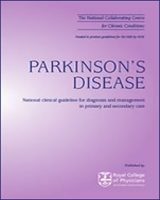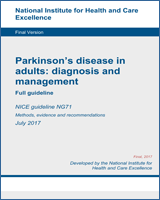All rights reserved. No part of this publication may be reproduced in any form (including photocopying or storing it in any medium by electronic means and whether or not transiently or incidentally to some other use of this publication) without the written permission of the copyright owner. Applications for the copyright owner’s written permission to reproduce any part of this publication should be addressed to the publisher.
NCBI Bookshelf. A service of the National Library of Medicine, National Institutes of Health.
National Collaborating Centre for Chronic Conditions (UK). Parkinson's Disease: National Clinical Guideline for Diagnosis and Management in Primary and Secondary Care. London: Royal College of Physicians (UK); 2006. (NICE Clinical Guidelines, No. 35.)
This publication is provided for historical reference only and the information may be out of date.

Parkinson's Disease: National Clinical Guideline for Diagnosis and Management in Primary and Secondary Care.
Show detailsGuideline title
Parkinson’s disease: diagnosis, management and treatment of Parkinson’s disease in primary and secondary care
Background
The National Institute for Health and Clinical Excellence (NICE or ‘the Institute’) has commissioned the National Collaborating Centre for Chronic Conditions to develop a clinical guideline on Parkinson’s disease (PD) for use in the NHS in England and Wales. This follows referral of the topic by the Department of Health and Welsh Assembly Government (see below). The guideline will provide recommendations for good practice that are based on the best available evidence of clinical and cost-effectiveness.
The Institute’s clinical guidelines will support the implementation of national service frameworks (NSFs) in those aspects of care where a framework has been published. The statements in each NSF reflect the evidence that was used at the time the framework was prepared. The clinical guidelines and technology appraisals published by the Institute after an NSF has been issued will have the effect of updating the framework.
Clinical need for the guideline
Parkinson’s disease is a progressive neurodegenerative condition leading to death of the dopamine-containing cells of the substantia nigra. The ‘cardinal signs’ of the disease are rest tremor, rigidity, and hypokinesia. Postural instability and falls occur later during the course of the condition. Additional common findings are asymmetric onset of symptoms and symptomatic response to L-dopa (levodopa). Although predominantly a movement disorder, cognitive impairments including dementia do occur. All of these problems lead to significant disability and handicap with impaired quality of life for both patients and their carers and increased healthcare costs.
Parkinson’s disease is one of the commonest neurological conditions. It is estimated to affect up to 160 per 100,000 of the general population with an annual incidence of 15–20 per 100,000. Many population studies have shown the rising prevalence with age (up to 2% of the population aged 80 and over). Around 1 in 7 cases are diagnosed below the age of 60 years.
The costs of treatment have been estimated at between £560,000 and £1.6 million per 100,000 of the population. Significant cost drivers include the onset of motor fluctuations, psychiatric symptoms, and institutional care. Parkinson’s disease is a frequent cause of falls, fractures, and hospital admission and is therefore a costly disease, especially in the later stages.10,362,415
The guideline
The guideline development process is described in detail in three booklets that are available from the NICE website (see ‘Further information’). The guideline development process: information for stakeholders13 describes how organisations can become involved in the development of a guideline.
This document is the scope. It defines exactly what this guideline will (and will not) examine, and what the guideline developers will consider. The scope is based on the referral from the Department of Health and Welsh Assembly Government (see below).
The areas that will be addressed by the guideline are described in the following sections.
Population
Groups that will be covered:
- both sexes over 20 years of age
- diagnoses: Parkinson’s disease and parkinsonism
- treatment: idiopathic Parkinson’s disease only.
Groups that will not be covered:
- juvenile onset Parkinson’s disease (<20 years)
- pregnant females
- treatment: parkinsonism (a neurological disorder that manifests with hypokinesia, tremor, or muscular rigidity) and other tremulous disorders (eg essential tremor) – except for accurate differential diagnosis.
Healthcare setting
The guideline will cover the care received from primary, secondary and tertiary NHS care settings.
Clinical management
The guideline will cover the following aspects of management.
Diagnosis and monitoring:
- clinical expert diagnosis (using UK PDS Brain Bank Criteria)
- – versus non-expert diagnosis
- – versus post-mortem gold standard
- other diagnostic tests (eg acute levodopa and apomorphine tests, radionuclide imaging: PET and SPECT, magnetic resonance imaging, magnetic resonance volumetry, magnetic resonance spectroscopy, growth hormone stimulation test).
Communication and education:
- communication of the diagnosis and patient understanding
- patient education (self-help), both specific and generic issues, including falls prevention
Pharmacotherapy:
- prevention of progression – the use of neuro-protective therapy (eg dopamine agonists, MAOB inhibitors, amantadine, co-enzyme Q10, vitamins).
- functional disability – treatment of early disease with:
- – immediate-release levodopa
- – modified-release levodopa
- – dopamine agonists
- – MAOB inhibitors
- – amantadine
- – anticholinergics
- – beta-blockers.
- adjuvant pharmacotherapy:
- – dopamine agonists
- – COMT inhibitors
- – MAOB inhibitors
- – amantadine
- – intermittent apomorphine injections and continuous infusion
- – treatment of non-motor symptoms (eg sleep disturbance).
Non-pharmacological management:
- current surgical options (eg deep brain stimulation)
- physiotherapy
- speech and language therapy
- occupational therapy
- Parkinson’s disease nurse specialists
Neuropsychiatric conditions
- psychosis management specific to PD
- depression management specific to PD
- dementia management specific to PD.
Palliative care:
- end-of-life issues specific to PD.
The guideline will not cover the following aspects of intervention/management.
- radical therapies that do not form common clinical management: fetal cell transplantation; stem cells; genes that code protein responsible for producing dopamine; drugs that block the action of glutamate; GDNF; viral transfection
- comorbidities in Parkinson’s disease (except where treatment will differ from treatment of these comorbidities in patients without Parkinson’s disease)
- generic health problems where the care for people with Parkinson’s disease does not differ to that of the general population (eg constipation).
Audit support within guideline
The guideline will include Level 1 clinical audit criteria.
Referral from the Department of Health and Welsh Assembly Government
The Department of Health and the Welsh Assembly Government asked the Institute in May 2002:
‘To prepare clinical guidelines for the NHS in England and Wales for the diagnosis, management and treatment of Parkinson’s disease in both primary and secondary care settings, including examination of the evidence for the effectiveness of management of the condition by physiotherapy, speech, language and occupational therapies, self-help, drug therapies and surgery.’
- The scope of the guideline - Parkinson's DiseaseThe scope of the guideline - Parkinson's Disease
Your browsing activity is empty.
Activity recording is turned off.
See more...
